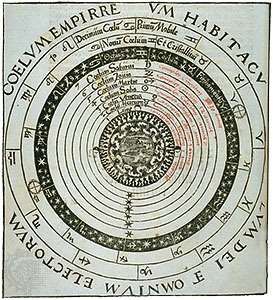Nicolaus Copernicus (1473-1543), considered as the founder of modern astronomy, was born into a wealthy family in Thorn, Poland on February 19, 1473. He was the son of Nicolaus, a well-to-do merchant, and Barbara Watzenrode, who also came from a leading merchant family. His writings cover various subjects including astronomy, economics, mathematics, canon law, medicine and politics. He proposed that the sun was stationary within the center of the universe and therefore the earth revolved around it. He was fluent in Latin, German, Polish, Greek and Italian, and had some knowledge of Hebrew.
Early Life And Education
Between 1491 and about 1494 Copernicus studied liberal arts—including astronomy and astrology—at the University of Cracow (Kraków). Like many students of his time, however, he left before completing his degree, resuming his studies in Italy at the University of Bologna, where his uncle had obtained a doctorate in jurisprudence in 1473. The Bologna period (1496–1500) was short but significant. For a time Copernicus lived within the same house because the principal astronomer at the university, Domenico Maria de Novara (Latin: Domenicus Maria Novaria Ferrariensis; 1454–1504). Novara had the responsibility of issuing annual astrological prognostications for town, forecasts that included all social groups but gave special attention to the fate of the Italian princes and their enemies. Copernicus, as is understood from Rheticus, was “assistant and witness” to a number of Novara’s observations, and his involvement with the assembly of the annual forecasts implies that he was intimately acquainted with the practice of astrology. Novara also probably introduced Copernicus to 2 important books that framed his future problematic as a student of the heavens: Epitoma in Almagestum Ptolemaei (“Epitome of Ptolemy’s Almagest”) by Johann Muller (also referred to as Regiomontanus, 1436–76) and Disputationes adversus astrologianm divinatricenm (“Disputations against Divinatory Astrology”) by Giovanni Pico della Mirandola (1463–94). the primary provided a summary of the foundations of Ptolemy’s astronomy, with Regiomontanus’s corrections and significant expansions of certain important planetary models that may are suggestive to Copernicus of directions resulting in the heliocentric hypothesis. Pico’s Disputationes offered a devastating skeptical attack on the foundations of astrology that reverberated into the 17th century. Among Pico’s criticisms was the charge that, because astronomers disagreed about the order of the planets, astrologers couldn't make certain about the strengths of the powers issuing from the planets.
In 1500 Copernicus spoke before an interested audience in Rome on mathematical subjects, but the precise content of his lectures is unknown. In 1501 he stayed briefly in Frauenburg but soon returned to Italy to continue his studies, now at the University of Padua, where he pursued medical studies between 1501 and 1503. At now medicine was closely allied with astrology, because the stars were thought to influence the body’s dispositions. Thus, Copernicus’s astrological experience at Bologna was better training for medicine than one may think today. Copernicus later painted a self-portrait; it's likely that he acquired the mandatory artistic skills while in Padua, since there was a flourishing community of painters there and in nearby Venice. In May 1503 Copernicus finally received a doctorate—like his uncle, in canon law—but from an Italian university where he had not studied: the University of Ferrara. When he returned to Poland, Bishop Watzenrode arranged a sinecure for him: an in absentia teaching post at Wrocław. Copernicus’s actual duties at the bishopric palace, however, were largely administrative and medical. As a church canon, he collected rents from church-owned lands; secured military defenses; oversaw chapter finances; managed the bakery, brewery, and mills; and cared for the medical needs of the opposite canons and his uncle. (Despite serving as a canon, Copernicus didn't become a priest.) Copernicus’s astronomical work came about in his spare time, except these other obligations. He used the knowledge of Greek that he had acquired during his Italian studies to organize a Latin translation of the aphorisms of an obscure 7th-century Byzantine historian and poet, Theophylactus Simocattes. The work was published in Cracow in 1509 and dedicated to his uncle. it had been during the last years of Watzenrode’s life that Copernicus evidently came up with the concept on which his subsequent fame was to rest.
Copernicus’s reputation outside local Polish circles as an astronomer of considerable ability is clear from the actual fact that in 1514 he was invited to supply his opinion at the church’s Fifth Lateran Council on the critical problem of the reform of the calendar. The civil calendar then in use was still the one produced under the reign of full general, and, over the centuries, it had fallen seriously out of alignment with the particular positions of the Sun. This rendered the dates of crucial feast days, like Easter, highly problematic. Whether Copernicus ever offered any views on the way to reform the calendar isn't known; in any event, he never attended any of the council’s sessions. The leading calendar reformer was Paul of Middelburg, bishop of Fossombrone. When Copernicus composed his dedication to De revolutionibus in 1542, he remarked that “mathematics is written for mathematicians.” Here he distinguished between those, like Paul, whose mathematical abilities were ok to grasp his work et al. who had no such ability and for whom his work wasn't intended.
Planetary observations:
Other observations
With Novara, Copernicus observed an occultation of Aldebaran by the moon on 9/3/1497. Copernicus also observed a conjunction of Saturn and the moon on 4/3/1500. He saw an eclipse of the moon on 6/11/1500.
Copernican system
Predecessors
Geocentric (Ptolemaic system) v/s
Heliocentric model of universe
Classical astronomy followed principles established by Aristotle. According to 16th century cosmology, formulated by the Alexandrian astronomer and mathematician Potelmy, it is assumed that Earth is stationary and at the center of the universe. The sun, moon, stars, planets and other celestial bodies all orbited Earth.
Copernicus
felt that Ptolomy’s theory was incorrect. Copernicus decided that he could achieve
his goal only through a heliocentric model. He thereby created an idea of a universe during
which the distances of the planets from the sun bore an immediate relationship to the dimensions of their orbits. All his observations
of the heaven were made using naked eye. He didn’t had the tools to prove his
theories.Copernicus’s heliocentric idea was very controversial at that time; nevertheless, it had been the beginning of
a change within the way the planet was viewed, and Copernicus came to be seen
as the initiator of the Scientific Revolution.
Copernicus cited Aristarchus of Samos in an early unpublished manuscript of De Revolutionibus (which still survives), though he removed the reference from his final published manuscript.
Copernicus was probably aware that Pythagoras's system involved a moving Earth. The Pythagorean system was mentioned by Aristotle.
Copernicus owned a replica of Giorgio Valla's De expetendis et fugiendis rebus, including a translation of Plutarch's relation to Aristarchus's heliostaticism.
In Copernicus' dedication of On the Revolutions to Pope Paul III—which Copernicus hoped would dampen criticism of his heliocentric theory by "babblers... completely unaware of [astronomy]"—the book's author wrote that, in rereading all of philosophy, within the pages of Cicero and Plutarch he had found references to those few thinkers who dared to maneuver the planet "against the standard opinion of astronomers and almost against wisdom."
The prevailing theory during Copernicus's lifetime was the one that Ptolemy published in his Almagest c. 150 CE; the world was the stationary center of the universe. Stars were embedded during a large outer sphere which rotated rapidly, approximately daily, while each of the planets, the Sun, and therefore the Moon were embedded in their own, smaller spheres. Ptolemy's system employed devices, including epicycles, deferents and equants, to account for observations that the paths of those bodies differed from simple, circular orbits centered on the planet.
Copernicus
Copernicus' Commentariolus summarized his heliocentric theory. It listed the "assumptions" upon which the theory was based, as follows:
De revolutionibus itself was divided into six sections or parts, called "books":
- General vision of the heliocentric theory, and a summarized exposition of his idea of the World
- Mainly theoretical, presents the principles of spherical astronomy and a list of stars (as a basis for the arguments developed in the subsequent books)
- Mainly dedicated to the apparent motions of the Sun and to related phenomena
- Description of the Moon and its orbital motions
- Exposition of the motions in longitude of the non-terrestrial planets
- Exposition of the motions in latitude of the non-terrestrial planets
















0 comments:
Post a Comment